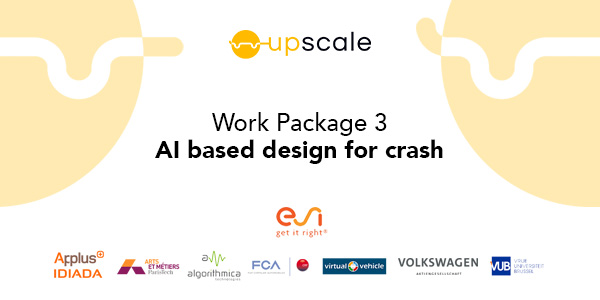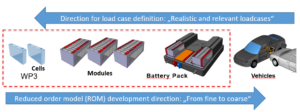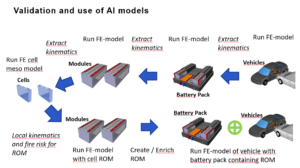In this interview, you will be able to discover the main activities and actions to be developed and the challenges and opportunities posed by the UPSCALE project.
The answers were prepared by the ESI GROUP team, leaders of the Work Package 3: AI based design for crash. Go ahead and read it!
ESI Group is a pioneer and world-leading provider in Virtual Prototyping, leveraging the physics of materials. The company provides virtual prototyping software that simulates a product’s behavior during testing, manufacturing and real-life use.
The main picture shows the other partners involved in this work package.
As leaders of the Work Package 3: AI based design for crash, which are the main expected results?
The WP3 will focus on the development of methodology and associated tools, to assess the design and to validate the integration of the Battery in Battery Electric Vehicle (BEV). It is innovative Hybrid methodology combining Predictive Battery Virtual Prototyping, based on detailed simulation and Data Model empowered by AI. The objective is to predict the battery behaviour in the context of crash BEV safety assessment. It will enable smarter engineering by exploring design scenarios, with cause & effect relationship, enabling reliable and efficient decisions process with predictive impact analysis along the value chain.
An inadequate BEV crash design will damage the cell and induce mechanical abuse of the Cell structure, which will result in chemical abuse, leading to thermal abuse and fire. The Kinematics will be extracted from vehicle crash scenario from regulations and propagated to the cell level. A detailed cell simulation will enable to assess short circuit risk and kinematics at the meso level. An AI model will be generated to provide the requested output at an efficient computational cost compatible with industry requirements and process.
The development and validation of computer-aided engineering (CAE) models to predict the mechanical behavior of bonded parts in a crash has been studied at length. How the integration of AI can make a difference?
The failure will be initiated locally, and it will propagate in the Battery. Therefore, UPSCALE will bridge the necessary multi-scales and the multi-physics between the driving phenomenon of cell short circuit (micrometer and weeks Central Processing Unit (CPU) scale) and the industrial requirements of full vehicle crash (meter and hour CPU scale). This will enable Original Equipment Manufacturers (OEMs) to predict battery internal short circuit in timeframe compatible with production requirements and thus limit overdesign the Battery Modules and Packs.
Direct finite element integration of cell details implies very large models and small-time steps: 1 billion 10µm solid elements for a battery with detailed cells versus 10 million shells of 3mm in a standard vehicle crash today. Computation on a single cell takes a few days whereas standard vehicle crash CAE is required to be run overnight.
A current CAE approach is to generate equivalent stiffness materials with a coarser mesh gauge in order to be compatible with production requirements. However, the detail of the equivalent stiffness material does not allow for reliable assessment of internal short circuit risk.
The integration of AI allows, from available data provided by fine-scale and high-fidelity simulations, extracting model relating the structural inputs with the selected quantities of interest, that then will allow real-time decision making in the design stage.
What does entail the implementation of the battery reduced-order methodology in crash simulations proposed by the project?
After mastering the full-scale model and developing deep understating of the overall phenomena, smart Parametric Reduced Model will be possible, accounting for the main drivers and their interactions. The new methodology requires change in the standard finite element simulation to allow hybrid approach, integrating AI-powered Data Model. This Battery Parametric Reduced Model order will improve the knowledge on the battery value chain (Cell / Pack /Modules/Vehicle / Environment) and establish cause & effect relationship for BEV safety requirements.
How UPSCALE is going to work in order to predict battery short circuits?
UPSCALE will use model reduction and AI to link kinematics on boundary nodes of a cell to stiffness and internal short circuit risk at micrometer length scale.
A realistic kinematic load database will be built based on vehicle load cases from regulations to ensure suitable training data. A detailed cell model will be used for linking the load cases with stiffness and internal failure risk. Its results will enable to build a reduced model of the cell with AI. The reduced model will then be validated on full car crash simulations.
How the ROM parameters will be defined?
The ROM parameters will use the kinematics of the boundary nodes will be used as inputs to predict cell stiffness and short circuit risk.
The AI model will be trained on the detailed ‘high fidelity’ cell standard finite element simulation loaded from kinematics load cases from vehicle. The internal short circuit is linked to mechanical failure of thin cell components.
The AI model will then be validated and predict kinematics and internal short circuit risk based on boundary kinematics.
How the cell battery modules will be modeled?
The cell battery module will be modelled with combined finite element module components and AI-powered super elements for each cell to model the stiffness and internal short circuit risk. Further reduction of the complete module might be assessed.






